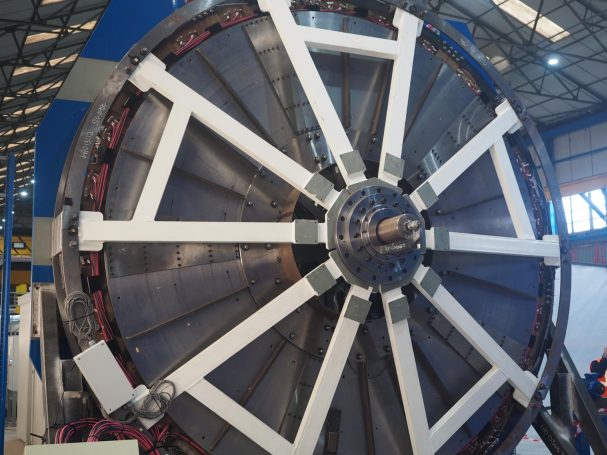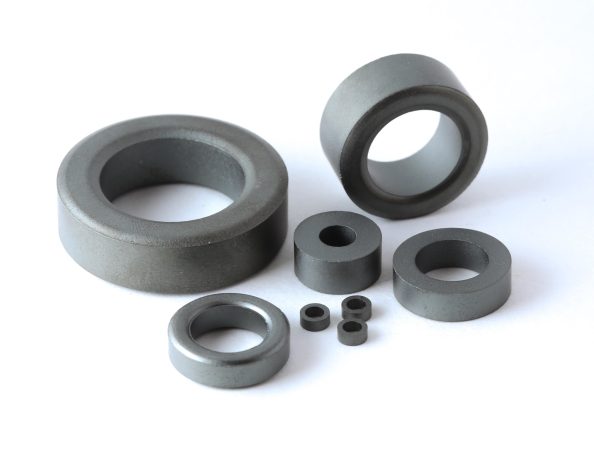Strontium (Sr)
Strontium is an alkaline earth metal. It’s appearance is a soft silver white yellowish metallic element that is highly chemically reactive. The main ores for strontium are celestine and strontianite. Strontium and strontianite are both named after Strontian, a village in Scotland, where they were first discovered in the lead mines in 1790.

End Uses:
Ferrite Magnets
Hard ferrite magnets are the most widely used magnetic material and are found in a wide range of applications including telecommunications, electric motors, and switches. Strontium ferrite magnets, which combine strontium carbonate and ferric oxide (aka rust), are the strongest type of ferrite magnet. Strontium ferrite magnets have a proven and easily scalable manufacturing process while offering reliable performance and resistance to corrosion at a relatively low cost compared to other magnet materials. Recent performance improvements in strontium ferrite magnet compositions and traction motor designs (by Sheffield, Cranfield, and Newcastle Universities, Hitachi/Proterial, General Motors, and possibly Tesla), and wind turbines (by Greenspur, a wind turbine manufacturer), are making high performance strontium ferrite magnets a viable alternative to rare earth permanent magnets. As well as their lower cost, they have lesser environmental impacts from processing, including no associated radioactivity, and less political risk attached to them. Strontium ferrite magnets offer a viable substitute in a range of applications, including electric motors and turbine generators, where functionality is less mass critical.
Zinc Smelting and Associated Minerals
Zinc is an important industrial metal, primarily used for galvanising steel. Special high-grade (SHG) zinc, which trades on the London Metal Exchange, must have a purity of 99.995%. To achieve this grade strontium carbonate is used in the purification process. Importantly, zinc ores like sphalerite are an important source of the critical elements germanium, gallium, and indium as a by-product from zinc production. The ability to produce SHG grade zinc can help bring mines into production therefore allowing by-product production of these vital enabling elements, that are currently under serious supply chain pressure.
Quantum Computing Processing
Strontium is a contender for use in quantum computer processors. Quantum computers execute operations exponentially faster than classical computers, allowing physicists to perform more complex simulations The building blocks of quantum computing are known as Rydberg atoms, however they have a very limited lifetime. Circular Rydberg states could solve this problem, as they have a much longer lifetime, allowing them to be used as qubits, an analogue to a bit in classical computing. The isotope of strontium (Sr-87) has two optically active electrons. Having two optically active electrons allows for more flexibility and stability, required for precise and stable computing. Furthermore, strontium can maintain very high circular energy states up to 2.55 milliseconds at room temperature. This is a very long time in the world of quantum computing.
Pyrotechnics
Strontium gives fireworks their red glow. Strontium has many different salts, a lot of which have applications in pyrotechnics. Strontium nitrate is used as both oxidiser fuel and red flame colorant. Strontium monochloride is also used as a flame colorant, burning with a deeper red colour, it is used in red flares for both military and civilian applications. Strontium peroxide burns with a vivid red colour, it is also an oxidising agent. Due to these properties it is used in both firework colourant and marine distress flares.
Specialty Paints and Glazes
Strontium can offer many different uses in paints and glazes. Compounds such as strontium chromate add vibrant colours to paints. Strontium can also increase the durability of a finish, especially improving a glaze’s resistance to fine cracks and scratches. Strontium compounds can be used to add special effects to paints. Strontium aluminate is used in non-radioactive glow in the dark paints, as it can store light and then slowly emit it over time. Strontium is used in many paints to improve the surface quality. It can produce finishes from satin to matte, in glasses it can be used to brighten the glossy finishes.
Medical Applications
Strontium has many important medical applications. Strontium ranelate is used to treat osteoporosis. It helps increase bone formation and reduce bone loss, lowering the risk of fractures. Strontium chloride is used in toothpaste to reduce tooth sensitivity. It helps block the pathways that lead to nerve endings, providing pain relief. There is ongoing research looking into using strontium for osteoarthritis, as it may help boost formation of collagen and cartilage in joints.
Ferrites magnets can be also made from barium carbonate, but have lower performance compared to Sr ferrites (barium carbonate is also mildly toxic and needs special handling), but barite (the primary ore of barium) should not be ignored as it has a myriad of end uses.
Barium (Ba)
Barium is another alkaline earth metal. Like strontium it is also highly reactive, therefore is never found as a free element, but instead resides in minerals. The most common ore minerals for barium are barite (barium sulphate) and witherite (barium carbonate). The name barium originates from the Greek word barys, meaning “heavy”. Barium was first discovered in 1772.

End Uses:
Ferrite Magnets
Barium ferrite magnets are produced using barium carbonate and iron oxide. Common applications of barium ferrites are magnetic strips for ID cards, speaker magnets, and tape data storage media. Barium ferrite magnets have a proven and easily scalable manufacturing process while offering reliable performance and resistance to corrosion at a relatively low cost compared to other magnet materials. Barium ferrites are cheaper than strontium ferrites, as they have a lower performance. Barium carbonate (in nature as the mineral witherite) needs special handling as it mildly toxic (it is actually used as a rat poison!).
Drilling fluid
Barite is used across the oil and gas industry as a weighting agent in drilling fluids. Barite has a high specific gravity of 4.2, making it ideal for controlling wellbore pressures and preventing blowouts during drilling. Barite is also a soft mineral, which means it will not damage drilling tools, and can act as a lubricant. Quality and grade are important consideration for drilling fluids.
Alloys
Barium is used in a wide range of alloys. Including in the manufacturing process of steel and cast iron to act as an inoculant, essentially it controls the solidification process, providing the desired microstructure and mechanical properties in the final product. It is added to tin solders for circuit boards, and barium nickel alloys are used in spark plugs.
X-ray Imaging
High grade barite is used in the medical industry to examine digestive systems, as it has low toxicity. The high specific gravity of barite enables to act as a radio contrast by blocking x-rays. Therefore an x-ray of a person who has consumed barite will show an outline of their digestive system, allowing medical professionals to determine if there are any issues.
Pyrotechnics
Like strontium nitrate, barium nitrate is used in pyrotechnics. It acts both as an oxidiser and as a colourant, giving fireworks an “apple green” colour. Barium chloride is used for a ‘brilliant’ green colour. Barium peroxide is used by militaries for green tracer ammunition and flares.
Thermite Reactions
Barium peroxide used as a catalyst in the aluminothermic reaction, or thermite reaction, which is used to repair and weld railway track together. Barium nitrate is also used in thermate composition, which is a thermite enriched with a salt based oxidiser.
Nuclear Power Plant Safety
Detail to follow
We need your consent to load the translations
We use a third-party service to translate the website content that may collect data about your activity. Please review the details in the privacy policy and accept the service to view the translations.







